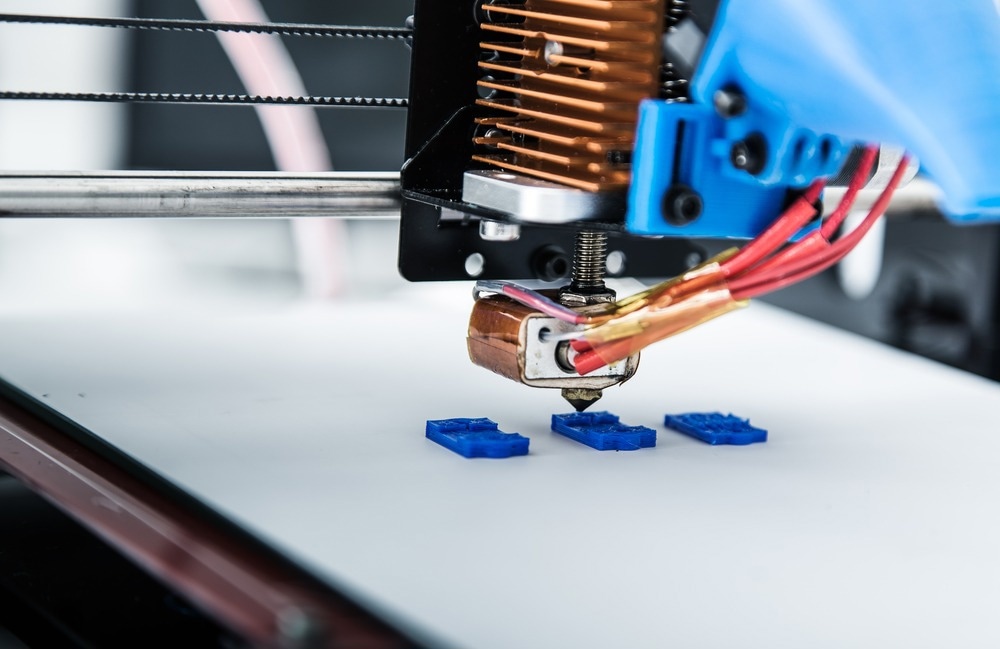 By Surbhi JainReviewed by Susha Cheriyedath, M.Sc.Aug 3 2022
By Surbhi JainReviewed by Susha Cheriyedath, M.Sc.Aug 3 2022In an article recently published in the journal Additive Manufacturing, researchers discussed the 3D printing of multi-material biomimetic composites using nonlinear coarse-graining models.

Study: Nonlinear Coarse-graining Models for 3D Printed Multi-material Biomimetic Composites. Image Credit: Alex_Traksel/Shutterstock.com
Background
The design space for synthetic engineering materials still needs to be expanded and optimized. The use of architected materials in additive manufacturing (AM) makes it possible to overcome this difficulty. However, the development of these materials has brought about new difficulties because it is not simple to locate the right design elements at smaller scales to produce the required and ideal combination of qualities at a bigger scale.
Researchers have recently developed microarchitectures with remarkable macroscale properties using a variety of techniques. One of these strategies is biomimetic design, which is applied to logically create a novel category of engineered materials called biomimetic architected materials (bio-AM).
Despite their benefits, bio-immensely AM's intricate microarchitectures make manufacture and analysis extremely difficult. New opportunities for fabricating these materials have been made possible by recent advancements in AM techniques. Voxel-based 3D printing, in particular, has the power to completely transform architectural materials. This AM method enables a dependable "voxel-by-voxel" microscale deposition of soft and hard material phases. This strategy, however, might result in microarchitectures that are incredibly detailed and quite difficult to evaluate with the finite element method. Using coarse-graining could be a good strategy to reduce the computational expense incurred by sophisticated bitmap designs.
About the Study
In this study, the authors predicted the elastoplastic mechanical behavior of biomimetic composites using foam-based constitutive equations in a nonlinear coarse-graining technique that was designed to solve this issue. The suggested method was verified by contrasting full-field strain distributions measured by digital image correlation with predictions from coarse-grained finite elements. Pre-notched specimens that were adorned with a binarized rendition of a well-known artwork were modeled in order to assess the effect of coarse-graining on model accuracy.
The team discussed the fracture behavior of bio-inspired composites integrating intricate patterns, like functional gradients and hierarchical structures, via coarse-graining. The inverse coarse-graining was combined with a theoretical model of bone tissue adaption to optimize the microarchitecture of a 3D-printed femur as a final demonstration of the suggested methodology. The predicted characteristics and the accompanying experimental findings agreed remarkably well. The coarse-graining approach enabled the creation of sophisticated architectural materials with controllable and predictable qualities.
The researchers created a coarse-graining method that made it possible to anticipate the nonlinear mechanical characteristics of bio-AM very effectively. To create the gray value-property estimate functions, the proposed technology integrated the design flexibility of voxel-based AM with the ease of foam-based constitutive models. The proposed strategy eliminated the need for computationally pricey models and provided bio-AM designers with a highly effective and affordable tool for rational bio-AM design.
The necessary data was generated to characterize the nonlinear equations and validated them using computational simulations after only a few mechanical testing. Then, FEA on a highly detailed portrait was used to examine the effects of the degree of coarse-graining by gradually increasing the coarse-graining degree. By applying this methodology to the examination of the ductile fracture behavior of the bioinspired materials, the applications of this approach were further illustrated.
Further, in order to acquire the microarchitecture of a modified femoral bone, an inverse coarse-graining process was used.
Observations
The force-displacement plots demonstrated how the remodeling process increased the bone's overall energy capacity. While the system's overall stiffness was lowered from 485.09 Nmm-1 to 205.67 Nmm-1, this technique predicted a maximum force improvement of 146% from 418.43 N to 612.85 N. The stiffness values predicted by the FE were between 92.8 and 93.6% of the corresponding experimental values, while the maximum force values predicted by the FE were between 81.0 and 85.2% of the corresponding experimental values.
The time needed to compute the elastic modulus and yield stress for the most coarse-grained models was reduced by three orders of magnitude, requiring only 0.45% and 0.3% of the initial time, respectively. The simulation time was significantly shortened by three orders of magnitude using coarse-graining and numerical modeling of the intricate bitmap designs while only slightly deviating from the actual mechanical response.
These grey-scaled structures could be discretized into manufacturable equivalents while retaining the exceptional mechanical response predicted by their computer counterparts.
Conclusions
In conclusion, this study demonstrated that foam-based constitutive equations could efficiently and precisely model the nonlinear mechanical behavior of bio-AM for large deformations. The user was given a methodology to coarse-grain large systems of binary images and represent them at smaller grey-scaled resolutions in order to perform nonlinear quasi-static numerical analyses and optimization processes by combining this straightforward and elegant system of functions with voxel-by-voxel 3D printing techniques.
The authors were able to analyze massive, complex bio-AM to examine local strain patterns and gauge performance thanks to the dramatic reduction in simulation time. They were also able to replicate the internal material distribution of a femoral bone that resulted from a remodeling method using the suggested coarse-graining approach, which produced a complicated local strain distribution that improved the structure's overall nonlinear response.
The authors mentioned that the suggested methodology opens up new possibilities for reliably and comprehensibly creating innovative materials given their required features. They also stated that incorporating more voxel-based methods into the design of their architected materials may be advantageous for a variety of high-tech industries, including soft robotics, aerospace, orthopedics, and tissue engineering.
Disclaimer: The views expressed here are those of the author expressed in their private capacity and do not necessarily represent the views of AZoM.com Limited T/A AZoNetwork the owner and operator of this website. This disclaimer forms part of the Terms and conditions of use of this website.
Source:
Saldívar, M. C., Doubrovski, E. L., Mirzaali, M. J., et al. Nonlinear Coarse-graining Models for 3D Printed Multi-material Biomimetic Composites. Additive Manufacturing 103062 (2022). https://www.sciencedirect.com/science/article/pii/S2214860422004547